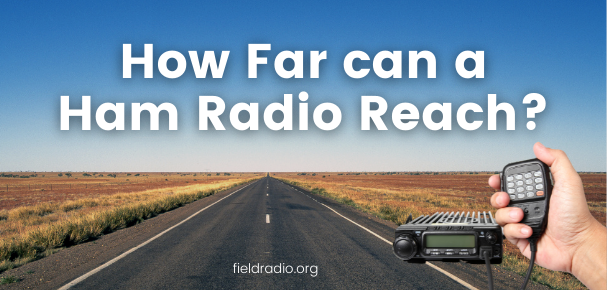A conversation using a Ham radio is a classic person-to-person communication that predates SMS and internet messaging. This is probably why it’s made an emergence over the past few years because of its nostalgic effect.
However, one of the major problems with Ham radio in the past, and even until now, is the fact that there’s a possibility for other people to listen in to conversations. This might make you wonder whether it’s possible to encrypt Ham radios in the first place?
Are you interested in knowing whether Ham radio encryption is possible? Continue reading this article to find out the answer.
Can You Encrypt Ham Radio Signals
Yes, technically, it’s possible to encrypt radio signals. There are several ways of doing so. For example, you modify the radio to send secure and encrypted broadcasts. This is what most law-enforcement agencies do.
But, there are several reasons why Ham bands are encryption-free, to begin with. This includes the following reasons:
- Amateur Services are for Learning
The main purpose of mature services is for learning. This is unachievable if others are unable to access particular frequencies.
- Nobody is Supposed to Own a Ham Radio Frequency
When you use encryption on the frequency, others will not be able to use the channel. As a result, it will look like you are taking ownership of that particular frequency.
- Ham Radio is Self-Policing
In the US, in particular, Ham radios are supposedly self-policing. This means that if others cannot monitor your signal, you are not following the rules.
- It’s the International Standard
During World War I and World War II, espionage was a real concern. As a result, most nations agreed that Ham bands should be encryption-free for transparency and so that it wouldn’t be used for such purposes. However, this reason is already obsolete nowadays.
The Legality of Ham Radio Signal Encryption
Is it legal to encrypt radio signals? The answer is it depends on where you are using it. In most countries, it is illegal for you to do so except for some special cases. This is why it’s important to do thorough research regarding the rules and regulations of using ham bands in your area to avoid any legal trouble.
There are Ham radios out there highlighting their encryption features like those from Baofeng. So, are Baofeng radios encrypted? Well, it can be, but whether you are allowed to use the feature or not depends on where you are using it . For example, encrypting Ham radio signals in the United States is illegal. But, in Australia, encryption is allowed for emergency communication.
Suppose you want to run packet radio with legal encryption. In that case, it’s highly recommended that you do it using MURS channels. These are mostly legal, but it would still be best if you check with your local regulations just to be sure.
Can Ham Radio Be Tracked
Can a Ham radio be traced? The answer is yes, but the chances of this happening to you are incredibly low. Most amateur users will not think of tracing the origin of a ham radio signal, but there could be others who wish to do so for both bad and good reasons.
It is possible to triangulate your ham radio signal, giving the person who wants to track down its origin a general location of where the signal is coming from. However, in order to successfully triangulate a ham radio signal, it should be active for a specific period of time.
How to Communicate Securely Using the Ham Radio
Is it possible to communicate securely using the Ham radio without using encryption? Although you cannot 100% eliminate the risk of somebody discovering and listening into your Ham conversation, there are steps that can help mitigate the risks. Here are some examples:
- Shorten Your Communication Window
As mentioned above, one way of having your Ham radio signal traced is by triangulating its location when it is active. This means that the less time it is active, the lesser chance of getting a more exact location as well.
Moreover, by shortening your communication window, you limit the amount of valuable information you are exposing. This can significantly help stop those who are not the intended receiver from getting the context of the message. Doing so makes them less likely to understand its meaning, especially since there’s no playback feature with these devices.
- Make Your Communication Schedule Unpredictable
Another excellent way of securing your Ham radio conversation without using encryption is by making your communication schedule unpredictable. By doing this, others will not be able to anticipate your conversation, mitigating the chances of somebody else listening in. Basically, you will be limiting the probability of other people discovering your broadcast.
- Use Coded Message
Encrypting the broadcast frequency is illegal in many countries in the world. However, what’s not illegal is encrypting the messages that you send. How exactly can you do this? Well, you can try using code words for events or locations. You can also use cipher techniques.
Whatever method of encrypting your message you use will significantly reduce the chances of sensitive information falling into the wrong hands. Plus, the coded message can be made into a fun puzzle for extra excitement.
Final Words
Ham radios are excellent devices with plenty of benefits. First, it provides a nostalgic feel to users and offers a similar experience to how it was several decades ago. Secondly, it’s good communication back up if ever there comes a time that modern methods of communication are unavailable due to natural disasters and other unforeseen circumstances.
However, it’s important for you to remember that communication privacy is not achievable using the Ham radio. Moreover, if you insist on encrypting it just to achieve that privacy, you might be committing a criminal offense.
When using a Ham radio, whether for entertainment or practical use, make sure to follow the rules and regulations in your area regarding its use. This way, you will be saving yourself from potential problems. You wouldn’t be disrupting any government bodies using ham bands for official purposes.

I have been passionate about the world of communications in its various forms for most of my life. Ever since I first found an old ham radio stashed away in my uncle’s attic, I have had a fascination with this classic technology.
Having the ability to communicate with people without the need to rely on telephone lines or networks is an empowering feeling which I believe everyone should have at least a basic knowledge of. Becuase who knows when you might need it?
I setup fieldradio.org with this passion in mind, to help inform people about the amazing possibilities of amateur radio and I’m on a quest to help educate as many budding operators as possible.
I hope you enjoy our content. Come and say hi, via our contact form


